Ceramics
The museum’s collection covers everything from Ancient Greek pottery to the latest in contemporary practice.
The museum’s collection covers everything from Ancient Greek pottery to the latest in contemporary practice.
This collection began in 1910 when a Preston solicitor, Cedric Houghton, left a bequest of around 400 items of pottery and porcelain to the Harris. Houghton’s expressed wish was that his personal collection should form the basis of a larger collection, and this has been the case. The ceramic collection now numbers almost 2,400 items, most of which are British but there are sizeable groups of Chinese, Japanese and European wares.
The collection largely shows the development of British ceramics from the 1600s to the mid-1900s. Highlights include Wedgwood jasperware, Staffordshire figures and early English porcelain as well as examples of loving cups, posset pots, punch bowls, tea sets and dinner services. Other significant personal collections are the Smith Collection of English Porcelain, the Bradshaw Collection of English Coffee Cups and the Millington Tile Collection.
There are also lots of commemorative pots on display – many of which have strong connections to Preston. These include temperance ceramics and Preston Guild ceramics from 1822 to 2012.
Collecting has recently focused on post-1900s studio and commercial ceramics with purchases of work by Bernard Leach, Katharine Pleydell-Bouverie and Clarice Cliff. Contemporary works include James Tower, Carol McNichol, Halima Cassell, Shigekazu Nagae Natasha Daintry, Morgan Dowdall and Malene Hartmann Rassmusen.
Date
Around 600 items from this collection are on display. Items not on display are in our stores and are available to view by appointment. Email theharris@preston.gov.uk.
Location
Ceramics & Glass Gallery on the 1st floor
Cost: free
This collection is free to visit
Exploring Ceramics

Mermaid Scent Bottle
Object number: F2250
This is a novelty ceramic scent bottle in the shape of a mermaid. Ceramic scent bottles like this were popular throughout the 18th and 19th centuries. They came in many shapes and styles from animals and figures through to those with ornately painted decoration. All the major ceramic manufactures, such as Chelsea, Wedgewood and Royal Worcester, made perfume bottles with many types of hand-painted decoration on them. During the Victorian period there was a fascination with novelties in the shape of other items and many scent bottles like this one were produced.

‘Tea for Two’ tea set painted with Gibraltar seascape
Made: Staffordshire
Date: 1932
Object number: 2013.29
Artist: Clarice Cliff
In 1927 Newport Factory in Staffordshire gave a young employee called Clarice Cliff a range of faulty blank ceramics to try to decorate for sale. Cliff chose an unusual bold and geometric pattern to cover flaws in the pots. To the company’s surprise, Cliff’s designs were instant bestsellers she became one of the most famous names in British ceramics. Cliff went onto design her own pottery shapes – including the ‘Stamford’ shape teapot seen here. You’ll find this tea set by Cliff alongside a range of factory produced ceramics – including the ‘Homemaker’ design by Enid Seed for Ridgway Potteries.

Charger decorated in slip with well in centre and hatched border
Made: Bernard Leach
Date: 1929
Object number: 2012.74
Bernard Leach was a British studio potter who strongly disliked factory-made ceramics. He felt that potters should dig their own clay, make their own glazes and throw their own pots. This charger was fired in Leach’s experimental Japanese-style, wood-fired kiln in St. Ives but it was damaged, splitting into 3 pieces. It was later repaired by the Leach family. The Harris has other examples British studio pottery by makers such as Michael Cardew and Katherine Pleydell-Bouverie.

Harlequinn Shifts – carved stoneware bowl
Date: 2005
Object number: 2008.23
Artist: Halima Cassell
Born in Kashmir in Pakistan, Cassell grew up in the North West and studied at UCLan in Preston. Cassell’s ceramics combine solid forms with highly complex, carved surface patterns. Cassell’s influences include Islamic architecture, North African surface pattern and Op Art. She increasingly works as a sculptor across many different materials including ceramics, bronze and marble. This is one of a growing collection of contemporary ceramics that you’ll find at the Harris.

NS-02 Forms in Succession
Date: 2010
Object number: 2013.21
Artist: Shigekazu Nagae
This ceramic can be displayed from any angle: it doesn’t have a front, back, top or bottom. It is made by melting two slip-cast porcelain rectangles together in the kiln. The intensity of heat warps the rectangles into these two interlocking shapes. This ceramic is part of the Harris’s ongoing collection of contemporary ceramic practice.
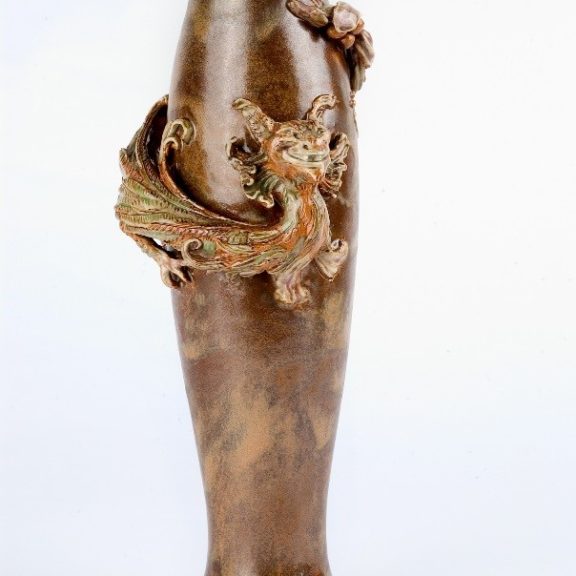
Vase with moulded dragon in stoneware
Made: By Doulton Lambeth from a design by the artist Mark V Marshall
Date: c. 1900
Object number: ce865
This vase was designed by the artist Mark V. Marshall for the Lambeth-based firm Doulton. This company started out making ceramic sanitary ware but from the 1870s it employed artists to produce a range of quirkier, more expensive items. You’ll find examples of Art Pottery in the Harris collection ranging from pieces decorated by Hannah and Florence Barlow for Doulton, and designs by Walter Crane and Jessie Jones for Pilkington’s.
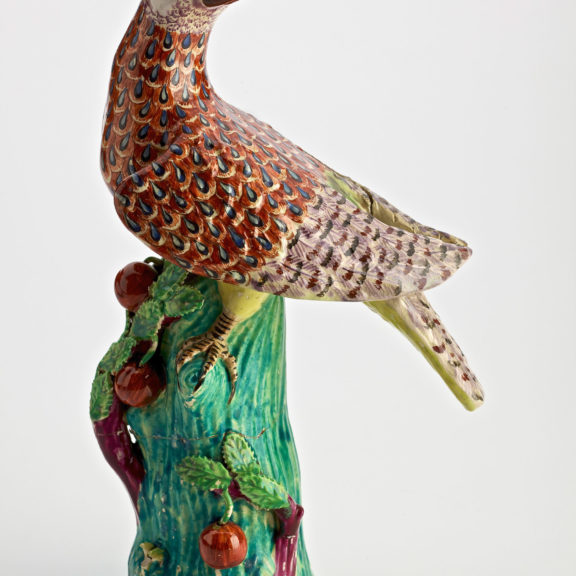
Figure of a bird standing on vegetation in painted earthenware
Made: In Staffordshire
Date: 1850s
Object number: ce584
This colourful bird figure is one of a number of ornamental figurines in the Harris collection – many of which were made in Staffordshire. This example is beautifully modelled and painted and must have been expensive to buy. Others Staffordshire figures are much simpler – made by pressing a sheet of damp clay into a simple mould. The Potteries were notorious in the 1800s for employing child workers to make simple Staffordshire figures. There is huge variety in the quality and subject matter of this type of ceramic – which can range from biblical and mythological characters, to romantic shepherds and even famous murderers of the day.

Vase with tripod legs and base in black basaltware
Made: In Staffordshire
Date: c.1760
Object number: ce279
Josiah Wedgwood is one of the most famous names in ceramics. The secret of Wedgwood’s success was a combination of pottery skill and business flair. Rather than competing with other British potters who were trying to crack the secret of making porcelain, Wedgwood concentrated on perfecting earthenware and stoneware. At the Harris you will find examples of the company’s creamware, jasperware and basaltware – including a chess set originally modelled by John Flaxman and an anti-slavery medallion which Wedgwood produced from 1787.

Tea set in white porcelain decorated with floral pattern and insects
Made: Made in China, decorated in Worcester
Date: c.1760
Object number: ce155
This porcelain tea set was made in China around 1760, but painted in Britain. Porcelain is known as ‘china’ because for centuries this was the only place which could find the right sort of clay to make this type of ceramic. It was a highly prized because of its whiteness, translucency and strength. The same ships which brought Chinese porcelain to this country also brought other new exotic products such as tea. You will find Chinese export porcelains in the Harris collection alongside early British porcelains by manufactories such as Bow, Chelsea, Worcester and Liverpool.
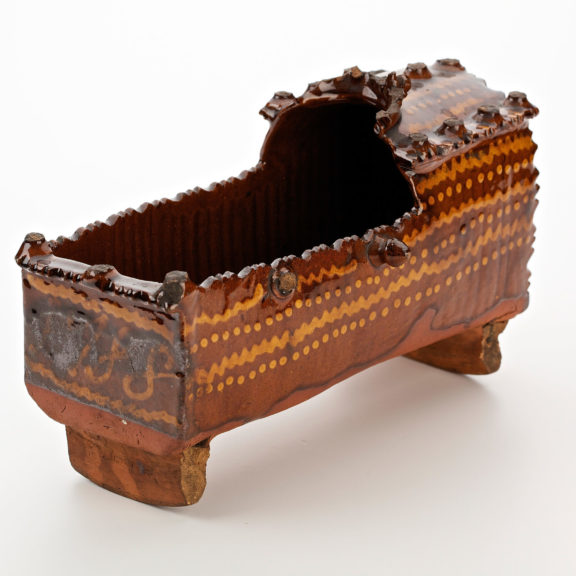
Model of cradle in brown tones decorated with cream slip
Date: 1788
Object number: ce180
This slipware cradle was probably made as a wedding present to wish a couple good fortune in their future family. It is called slipware because the potter has dotted and trailed liquid clay, known as slip, to create patterns. Many new types of pottery developed in Britain during the 1700s – including tin-glazed and lead-glazed earthenware and salt-glazed stoneware. You’ll find examples of all these types of pottery in the Harris collection.
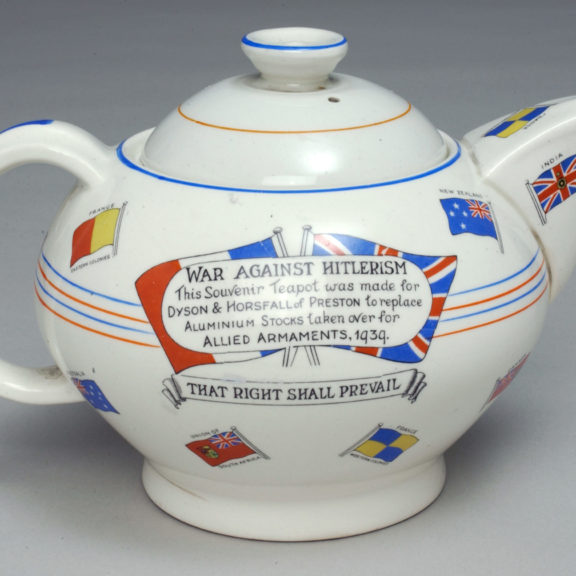
Teapot marked ‘War Against Hitlerism’ made for Dyson & Horsfall
Made: A. G. Richardson & Company, Tunstall, Staffordshire as part of their Crown Ducal range
Date: 1939
Object number: 1994.12
This patriotic teapot was made for Dyson & Horsfall, a mail-order company in Preston specialising in Christmas catalogues. Before the war the company had a popular line in aluminium teapots, but with the war effort requiring people to surrender metal items they produced a ceramic teapot in 1939. You’ll find loads of pots about Preston at the Harris – including examples of Preston Guild pottery from 1802 to 2012 and a teapot made to celebrate Preston North End’s only FA Cup Victory in 1938.
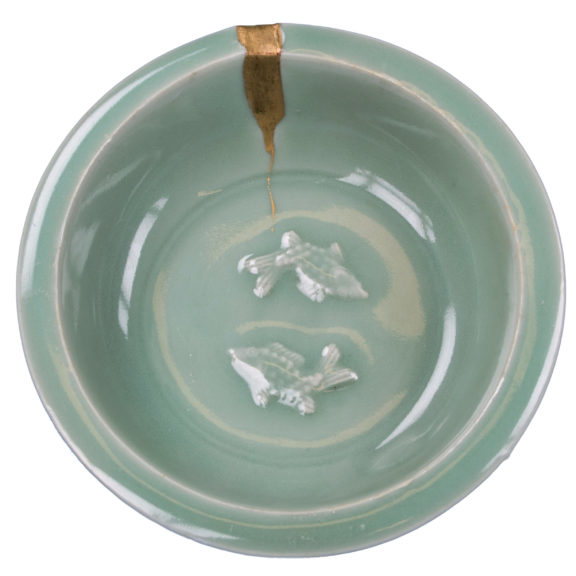
Bowl decorated with 2 fish in green-glazed porcelain with gold repair
Made: In China
Date: Between 960-1368
Object number: ce571
This Chinese porcelain bowl made over 1000 years ago celebrates imperfection – whether in life, love or pots. It was made to celebrate a marriage, but during firing process the pot cracked. Rather than starting again the potter has used gold leaf to make a repair. The Harris has a small but significant collection of ceramics from around the world – ranging from ancient Etruscan vases to Hispano-Moresque lustreware and Mexican blackware.

